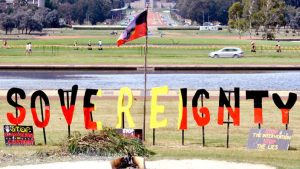
Anzac Day Reflections organised by the Gallipoli Centenary Peace Campaign and actively supported by the Marrickville Peace Group in past years have always recognised the Frontier Wars and Indigenous people’s call for constitutional reforms to help them take their rightful place in society.
In keeping with this tradition, Peter Griffin has written a paper exploring the character of Indigenous sovereignty and the obstacles to its realisation. Below is a synopsis of his paper. The full paper can be read here.
The clash of civilisations between Aboriginal and Colonial Australia was instantaneous and violent. The sense of threat felt by the Aboriginal inhabitants was validated by a range of destructive actions and legal and social exclusions. After the initial period of warfare lasting some 44 years and constitutional failure to recognise the First Nations, a whole series of measures were inflicted upon the Indigenous population with the deliberate intention of racial eradication.
The post Frontier War period was marked by the expectation of the dying out of “full blood” Aboriginals and the disappearance of “half caste” people by policies of assimilation. The same period was marked by calls for a Treaty and the establishment of Aboriginal rights. In recent times, the call for a Treaty was been replaced by Reconciliation. However this has failed to satisfy the aspiration for self determination.
The real goal remains Indigenous sovereignty. But this seemingly clashes with non-Indigenous sovereignty. But as the Uluru Statement from the Heart states “with substantive constitutional change and structural reform … this ancient sovereignty can shine through as a fuller expression of Australia’s nationhood.”